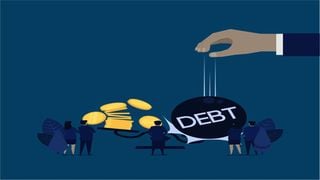
Kenya's debt crisis has been cooking since the Jubilee administration took charge.
| FileFinance and Markets
Premium
Year of debt pain: Digging Kenya out of financial hole
What you need to know:
- Kenya, which relies on tourism for 10 per cent of the country’s GDP and 9 per cent of the total employment, was in trouble.
With GDP shrinking into near-recession, the Sh7 trillion debt hit 69.2 per cent of the economy in August.
A black heron walking on Mombasa Road, Nairobi, in the early evening, captured the moment Kenya had run out of tourists who would pay top dollar to travel, drive a 4X4 truck and sleep in luxury hotels just to set eyes on the bird.
In April, only 3,101 foreigners landed at the Jomo Kenyatta International Airport — a 97 per cent decline from last year.
Between January and April, there were 392,691 arrivals — almost half the 619,698 tourists recorded in the same period last year.
Kenya, which relies on tourism for 10 per cent of the country’s GDP and 9 per cent of the total employment, was in trouble.
What is more, the leading foreign exchange earner that generated Sh163.6 billion in earnings in 2019 was gone as a result of the coronavirus pandemic, exposing the country to twin problems on debt — the cost of existing debt and sustainability.
Without dollar inflows, the shilling weakened, increasing Kenya’s dollar debt by Sh305.6 billion over the year as the Kenyan currency hit a new low of Sh111.3 against the greenback.
Sh7 trillion debt
With GDP shrinking into near-recession, the Sh7 trillion debt hit 69.2 per cent of the economy in August.
“The shilling depreciation will definitely mean that we need more money to pay our debts,” said Mr Renaldo D’Souza, the head of research at Sterling Capital. As the debt became bigger and the economy shrunk, Kenya was suddenly thrown into the group of countries that faced difficulty in repaying debt.
Ecuador and Rwanda have struggled to repay their debts while Zambia has officially defaulted alongside Lebanon, while Argentina is heading for its ninth sovereign default since independence in 1816.
While the pandemic was the straw that broke the camel’s back, Kenya’s debt crisis has been cooking since the Jubilee administration took charge.
When President Daniel Moi left office, Kenya’s public debt stood at Sh629 million and 60 per cent of GDP. President Mwai Kibaki left a decade later with a debt of Sh1.79 trillion, but with an expanded economy to support it, putting debt at 41 per cent of GDP.
Sh6.1 trillion
President Kenyatta’s Jubilee administration is set to have borrowed at least Sh6.1 trillion to implement his manifesto in 10 years in power, having inherited slightly more than Sh1.79 trillion in June 2013.
Treasury chiefs project new loans of Sh1.87 trillion in the two years to June 2022, meaning the Kenyatta administration will have borrowed Sh2.5 billion daily, pushing Kenya’s debt to Sh8.06 trillion.
So reckless was the borrowing that the administration took very expensive short-term loans akin to overdraft or Fuliza. Kenya under the Jubilee administration has borrowed nine syndicated loans compared to a single one during the tenure of President Kibaki.
In 2019, Parliament tried to stop the count, setting a Sh9 trillion debt ceiling, but since Kenya is in a deep hole, it can only dig itself deeper into the pit, and the ceiling is about to be breached.
“As at August 2020, the stock of public debt stood at Sh7.06 trillion. This, together with committed undisbursed debt of Sh1.35 billion, translates to a stock of public debt of Sh8.41 trillion against a ceiling of Sh9 trillion, which implies limited space for additional borrowing,” Finance Cabinet Secretary Ukur Yatani said of the post Covid-19 recovery strategy.
The CS said Kenya could simply not meet debt payments since we need half of all our revenues to service repayments while paying salaries, meeting county disbursement, pensions and building hospitals and schools.
Due credit has to be given to the new Treasury team that inherited an almost impossible job. They have been daring and ambitious.
Multilateral lenders
Since 2019, when Treasury Cabinet Secretary Henry Rotich was sacked and the first director-general of the Public Debt Management Office at the Treasury, Mr Haron Sirima, was appointed, Kenya has not borrowed from bankers or gone for the Eurobond.
Treasury said it would seek to push wealthy countries and multilateral lenders such as the World Bank to cancel part of its ballooning public debt. It will also consider taking a Sh75 billion debt repayment break from G20 countries, which will reduce debt servicing costs.
In addition, Kenya made its first conversion of a Treasury Bill into a long-term treasury bond, a strategy called a switch bond, which has helped the government delay the repayment of Sh25 billion.
Meanwhile, the team is toying with the idea of having pension funds freeze interest payments for two years and save the state up to Sh60 billion a year, according to the Actuarial Society of Kenya, since 40 per cent of the Sh1.3 trillion pension assets are invested in the government.
Treasury has reverted to multilateral development institutions, borrowing Sh75 billion from the World Bank last year and a further Sh100 billion this year. Treasury also borrowed Sh79.3 billion from the International Monetary Fund (IMF).
Kenya has now applied for $2.3 billion (Sh250.4 billion) from the IMF and $1.5 billion (Sh150 billion) from the World Bank.





